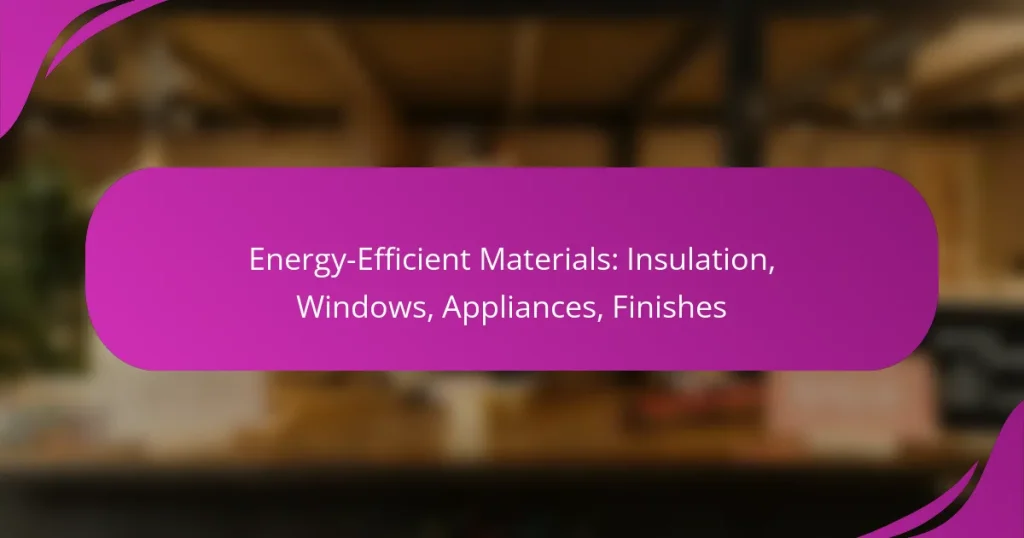Energy-efficient materials play a crucial role in enhancing the sustainability and comfort of homes. From advanced insulation options like fiberglass and spray foam to high-performance windows that regulate temperature, these materials significantly reduce energy consumption. Additionally, incorporating Energy Star-rated appliances further contributes to lower utility bills and a greener lifestyle, making them essential for modern Canadian households.
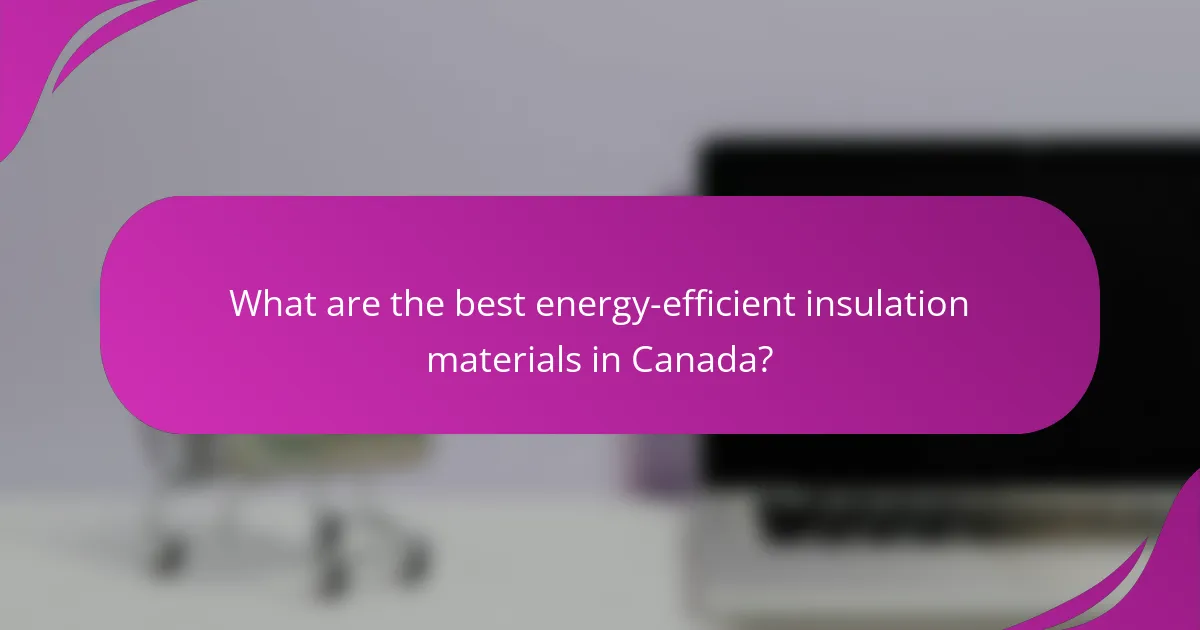
What are the best energy-efficient insulation materials in Canada?
The best energy-efficient insulation materials in Canada include fiberglass, spray foam, cellulose, mineral wool, and reflective insulation. Each type has unique properties that contribute to energy savings, comfort, and environmental impact, making them suitable for various applications in Canadian homes.
Fiberglass insulation
Fiberglass insulation is one of the most common types used in Canadian homes due to its affordability and effectiveness. It consists of tiny glass fibers that trap air, providing excellent thermal resistance, typically rated between R-11 to R-38 depending on the application.
When installing fiberglass insulation, ensure it fits snugly without gaps, as this maximizes its efficiency. It is available in batts, rolls, and loose-fill forms, making it versatile for different areas of the home.
Spray foam insulation
Spray foam insulation offers superior air sealing and thermal performance, expanding upon application to fill gaps and cracks. It typically has an R-value ranging from R-5 to R-7 per inch, making it one of the most effective insulation materials available.
While spray foam is more expensive than other options, its long-term energy savings can offset initial costs. Consider hiring a professional for installation to ensure proper application and safety, as it requires specific handling techniques.
Cellulose insulation
Cellulose insulation is made from recycled paper products and is treated with fire retardants, making it an eco-friendly choice. It typically has an R-value of around R-3.5 to R-4 per inch and is excellent for reducing air leakage when densely packed.
Cellulose can be blown into walls and attics, providing a seamless barrier against heat loss. Ensure that the installation is done correctly to avoid settling, which can reduce its effectiveness over time.
Mineral wool insulation
Mineral wool insulation, also known as rock wool, is made from natural or recycled materials and is fire-resistant. It offers an R-value of approximately R-3.1 to R-4.2 per inch and provides good soundproofing qualities, making it ideal for multi-family dwellings.
This type of insulation is hydrophobic, meaning it resists water absorption, which helps maintain its insulating properties even in damp conditions. Proper installation is crucial to maximize its benefits, especially in areas prone to moisture.
Reflective insulation
Reflective insulation is designed to reduce heat gain in warmer months by reflecting radiant heat away from living spaces. It is often used in attics and can be combined with other insulation types for enhanced performance.
Typically, reflective insulation is made of aluminum foil and works best in hot climates but can still be beneficial in Canada during summer. Ensure proper installation with air gaps to maximize its effectiveness in reflecting heat.
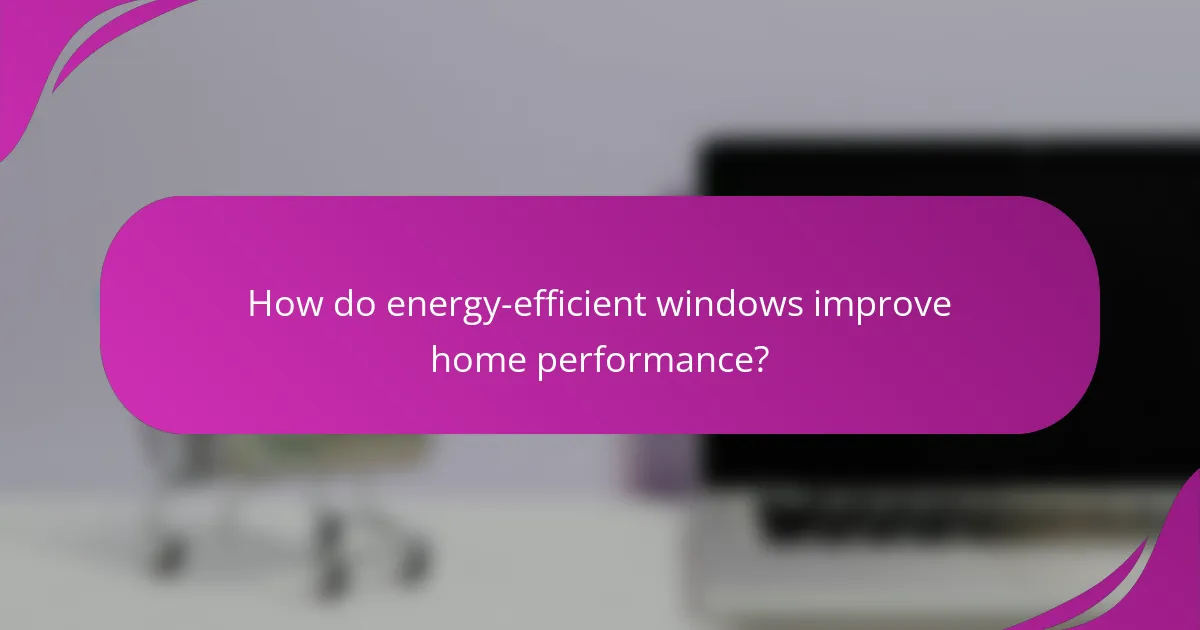
How do energy-efficient windows improve home performance?
Energy-efficient windows enhance home performance by reducing heat loss in winter and minimizing heat gain in summer. This leads to lower energy bills and improved indoor comfort throughout the year.
Low-E glass technology
Low-E (low emissivity) glass technology involves a special coating that reflects heat while allowing natural light to enter. This coating helps keep homes warmer in winter and cooler in summer, significantly improving energy efficiency.
When selecting windows, look for Low-E coatings with a high Solar Heat Gain Coefficient (SHGC) for warmer climates and a low SHGC for cooler areas. This ensures optimal performance based on your local climate conditions.
Triple-pane windows
Triple-pane windows consist of three layers of glass, providing superior insulation compared to single or double-pane options. The additional pane creates extra airspace, which reduces heat transfer and enhances soundproofing.
While triple-pane windows can be more expensive upfront, they often result in greater long-term energy savings, especially in regions with extreme temperatures. Consider the payback period based on local energy costs when making your choice.
Gas-filled windows
Gas-filled windows use inert gases like argon or krypton between the panes to improve thermal performance. These gases are less conductive than air, reducing heat transfer and increasing the window’s insulation value.
When choosing gas-filled windows, ensure they are properly sealed to prevent gas leakage, which can diminish their effectiveness over time. Look for windows with a good warranty to protect your investment.
Energy Star certification
Energy Star certification indicates that windows meet strict energy efficiency guidelines set by the U.S. Environmental Protection Agency. Certified windows help reduce energy costs and greenhouse gas emissions.
When shopping for windows, look for the Energy Star label, which provides information on performance ratings. This can guide you in selecting windows that are suitable for your climate zone and energy-saving goals.
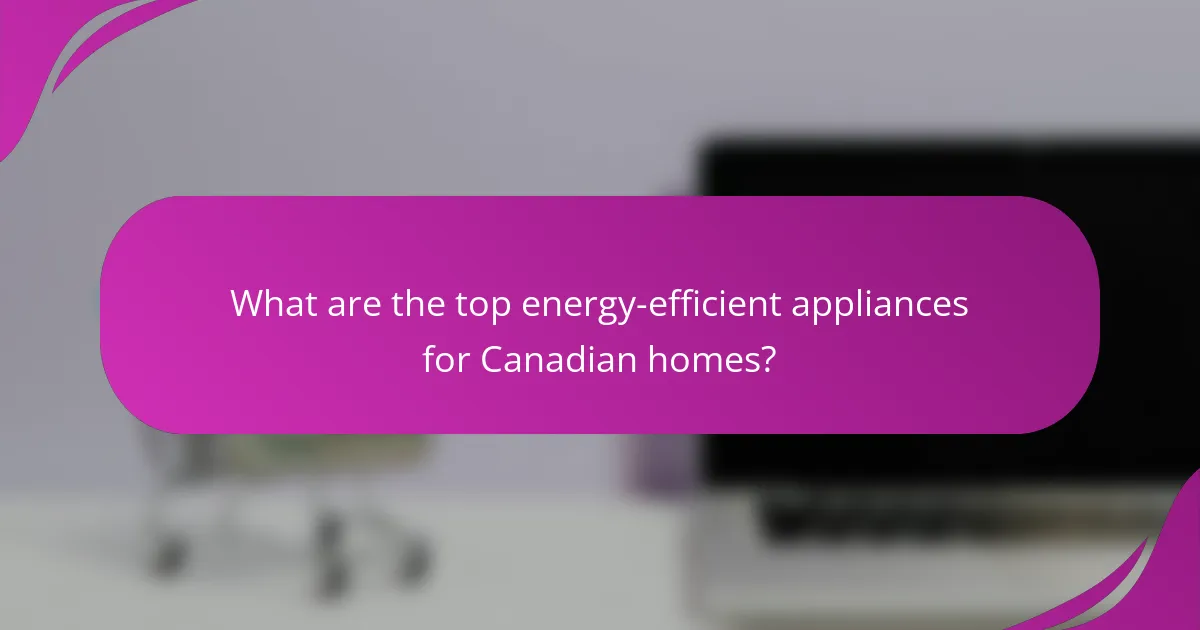
What are the top energy-efficient appliances for Canadian homes?
The best energy-efficient appliances for Canadian homes include Energy Star-rated refrigerators, high-efficiency washing machines, smart thermostats, and induction cooktops. These appliances not only reduce energy consumption but also lower utility bills and contribute to a more sustainable lifestyle.
Energy Star-rated refrigerators
Energy Star-rated refrigerators are designed to use significantly less energy than standard models, often consuming about 15% less. When shopping, look for models with high energy efficiency ratings and features like LED lighting and efficient compressors.
Consider the size and layout of your kitchen when choosing a refrigerator, as larger units may consume more energy. Opt for models with adjustable shelves and temperature controls to maximize efficiency.
High-efficiency washing machines
High-efficiency washing machines use less water and energy compared to traditional models, making them an excellent choice for eco-conscious households. These machines often feature advanced technology that optimizes water usage and cycle times.
When selecting a washing machine, look for front-loading models, which generally use less water and energy. Check for the Energy Star label to ensure you are choosing a model that meets energy efficiency standards.
Smart thermostats
Smart thermostats can significantly enhance energy efficiency by learning your schedule and adjusting heating and cooling accordingly. They can save homeowners up to 10-15% on heating and cooling costs annually.
When installing a smart thermostat, ensure it is compatible with your heating and cooling system. Features like remote access and energy usage reports can help you monitor and optimize your energy consumption.
Induction cooktops
Induction cooktops are highly efficient, using electromagnetic energy to directly heat pots and pans, which reduces cooking time and energy waste. They can be up to 90% efficient compared to traditional gas or electric stoves.
When considering an induction cooktop, ensure your cookware is compatible, as it must be made of ferrous materials. Look for models with multiple cooking zones and adjustable heat settings for versatility in meal preparation.

How to choose energy-efficient finishes for your home?
Choosing energy-efficient finishes for your home involves selecting materials that minimize environmental impact while enhancing insulation and sustainability. Focus on products that reduce energy consumption and improve indoor air quality.
Low-VOC paints
Low-VOC (volatile organic compounds) paints are formulated to emit fewer harmful chemicals compared to traditional paints. These paints not only improve indoor air quality but also contribute to a healthier living environment.
When selecting low-VOC paints, look for products that meet environmental standards such as Green Seal or the EPA’s Safer Choice label. These paints often come in a variety of colors and finishes, making it easy to find options that suit your aesthetic preferences.
Sustainable flooring options
Sustainable flooring options include materials like bamboo, cork, and reclaimed wood, which are renewable and have a lower environmental impact. These choices can enhance energy efficiency by providing better insulation and reducing heating and cooling costs.
Consider factors such as durability, maintenance, and lifecycle impact when choosing flooring. For instance, bamboo grows rapidly and can be harvested sustainably, while cork is harvested without harming the tree, making it an eco-friendly choice.
Recycled countertops
Recycled countertops, made from materials like glass, paper, or reclaimed stone, offer a stylish and environmentally friendly alternative to traditional surfaces. These countertops can reduce waste and lower the demand for new raw materials.
When selecting recycled countertops, check for certifications that indicate the percentage of recycled content. Options like recycled glass can provide unique aesthetics while being durable and easy to maintain, making them a practical choice for kitchens and bathrooms.
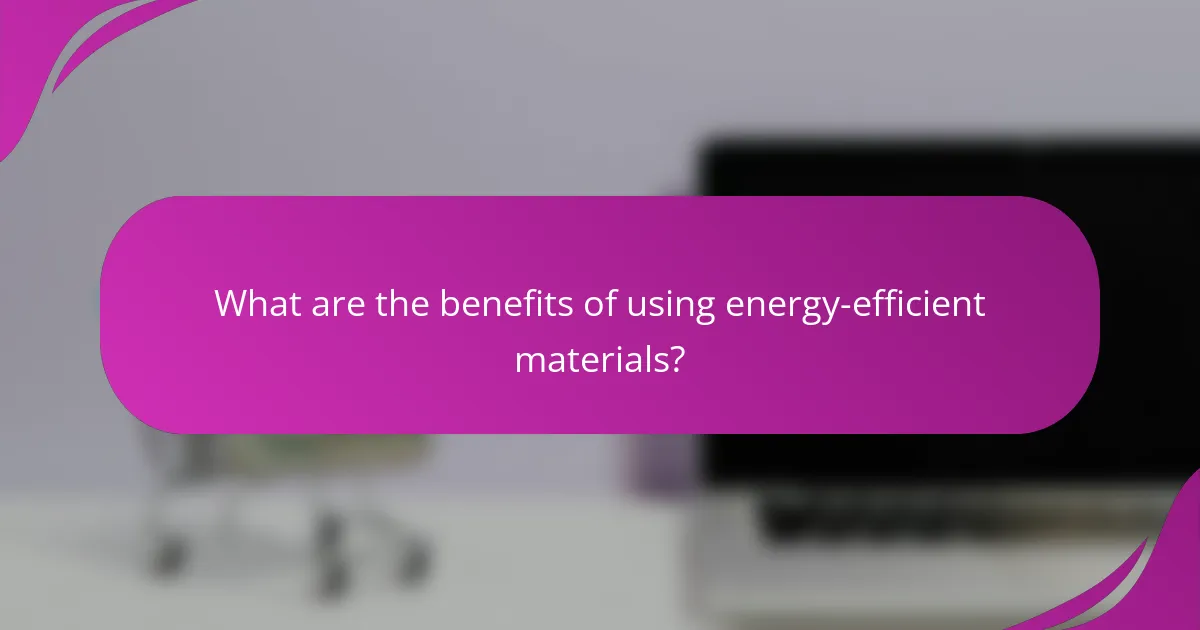
What are the benefits of using energy-efficient materials?
Using energy-efficient materials leads to significant advantages, including reduced energy consumption, lower utility costs, and enhanced comfort in living spaces. These materials help minimize heat loss in winter and keep homes cooler in summer, ultimately contributing to a more sustainable environment.
Lower energy bills
Energy-efficient materials can substantially lower energy bills by reducing the amount of energy needed for heating and cooling. For instance, high-quality insulation can decrease heat transfer, allowing homeowners to maintain comfortable temperatures without relying heavily on heating or air conditioning systems.
Windows designed with energy-efficient features, such as double or triple glazing, can further minimize energy costs by preventing heat loss. Homeowners can expect savings of around 10% to 30% on their energy bills when upgrading to these materials, depending on the climate and existing home conditions.
To maximize savings, consider conducting an energy audit to identify areas where energy-efficient materials can be implemented. Focus on insulation, windows, and energy-efficient appliances, as these are often the most impactful upgrades for reducing monthly expenses.
